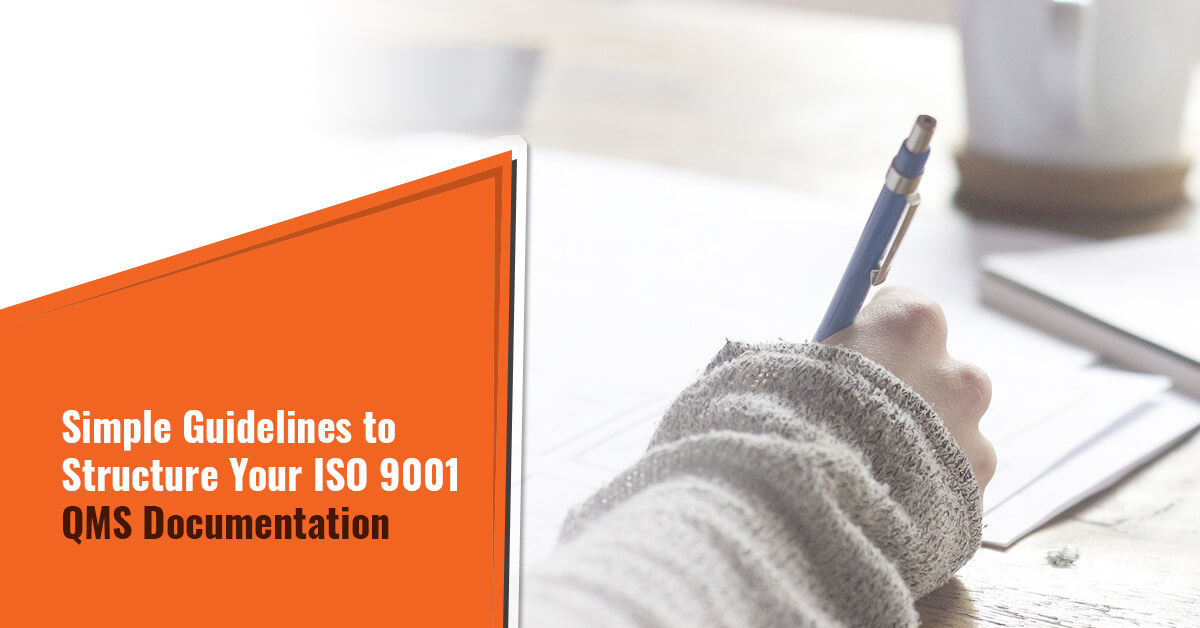Simple Guidelines to Structure Your ISO 9001 QMS Documentation
Gaining the ISO 9001 certification is an intricate and time-consuming process and that is why many organizations require external assistance to navigate them through the process of certification. Consultants help you understand the requirements of ISO 9001 and what the documents required for ISO certification are. Documentation is an integral step for achieving certification, as it is the record of compliance. Documenting your procedures and practices for a quality management system (QMS) is also regarded as a good business practice.
Organizations envision that there are loads of documents needed to achieve compliance with ISO 9001 along with many bureaucratic procedures. However, the truth is documentation can be done in a simple and effortless way. It is just that many organizations often go overboard in specifying the procedures of their QMS in writing. With a professional quality assurance agency guiding you through the certification, you can know the dos and don’ts of documentation. They can specify to you the documents or records needed for your QMS and eventually help you in preparing them.
Structuring the documentation of QMS is quite a systematic process. The next section explains the ideal requirements for good documentation of QMS.
Essentials for Documentation of ISO 9001 QMS
The following are the key considerations for documenting your QMS and preparing it for the ISO 9001 certification.
Quality Policy
The first requirement for documentation is a ‘quality policy’. The policy is like the declarative statement that should specify your organization’s quality objectives and practices for continual improvement. Your quality goals or objectives must be determined as per your organization’s purpose, products or services, and customer expectations. Documenting the policy precisely is necessary so that the quality objectives and purpose of the QMS is communicated well to everyone in the organization.
Quality Manual
The quality manual defines the structure and scope of your QMS. It hence varies with organizations depending on their number of processes, size of the workforce, complexities in operations, and quality requirements for products or services. Many large organizations with multiple setups and a vast number of processes can even have more than one quality manuals.
A proper quality manual should be documented with following details:
• Scope of the QMS
• Business process model
• Roles and responsibilities of employees
• Exclusions from the ISO 9001 standard
• References to quality-management related documents
• A quality manual also should include the envisioned objectives and ‘quality policy’ of your organization.
QMS Procedures
The QMS procedures depend on the specific requirements for the quality of your products or services. Hence, they vary in format or structure. Documenting the procedures is necessary to provide a narrative to the employees about their roles in the QMS. The procedures must be presented in a more illustrative way i.e., with a combination of flow charts, text, and tables to help employees or teams clearly understand their part of the job respectively.
Quality management system procedures of an organization generally include the following aspects:
• Title for the set of procedures
• Purpose or rationale of the procedures
• Scope which explains the key elements covered by each procedure
• Responsibilities of the employees and organization’s authorities in any procedure
• Outcomes or list of performance metrics that would result from the procedures
• Document control i.e. schedules for reviewing, identification of changes, approval of the QMS procedures
• Description of the procedures which means activities to be performed under each procedure. It also should include how, by whom, where and when the activities are to be performed
Work Instructions
Work instructions should be a part of the documentation procedure and it is required to ensure clarity of the procedures for the staff or employees. The instructions include every detail of the activities which are to be performed i.e., steps involved, tools required, and useful methods needed for maintaining accuracy in the procedures. Apparently, when you have work instructions meticulously documented, it reduces the need for providing training to the employees.
Records
Recording the outcomes of your QMS processes is essential as it helps in demonstrating whether they met the requirements for quality. It is useful during the external audits to reveal the competence of the QMS and how far it is successful in complying with the conditions of the ISO 9001 standard. The records have to be prepared by the owner of each procedure and they need to precisely state how the activities are conducted and what results came out of them. Filling of forms or templates is also included as a part of record-keeping, where the process owners have to fill in some concise information regarding their processes.
Key Takeaway!
Systematic and accurate documentation is the key to an effective QMS. Is this true? Yes, it is. The more accurate and structured is your documentation, the better it is. It clearly communicates the functions of your QMS across everyone in your organization and makes them easier to conduct. However, seeking expert assistance to know what the documents required for ISO certification are is recommended. Quality assurance specialists have in-depth understanding of the ISO 9001 requirements. They prevent you from missing any aspect in the documentation which can be a cause of non-compliance with ISO 9001 during the certification audit.
Need help with documentation for ISO 9001 QMS? Compliancehelp Consulting LLC has the best team of quality assurance consultants who can tell you how to proceed with your documentation of QMS leaving no chances of errors or noncompliance.

